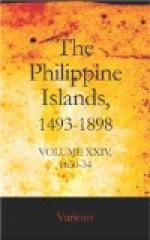In Japon they are still pricked with the thorn of the ship which some years ago our galleons captured and burned on the bar of Sian. To avenge this, notable councils have been held in Japon, in order to come and wage war against this land; in order beforehand to have it well explored, they sent last year in January two merchant ships, under cloak of trade and traffic. Although in Manilla warning of this double object had been received, this was not made known; and they were received and regaled as ambassadors from the Tono of Arima and Bungo. A ceremonious reception and very handsome present were given to them; but the city was put in readiness for whatever might happen. This year they have begun again to send ships to trade and traffic, and asked that our ships should go to Japon. But we are holding back here, because what they wish to do is to seize the property which might be in the vessels, and put the Castilians to the sword. They sent in these ships a hundred or more Christian lepers, who, whatever they did with them, would not abandon the faith; and in order not to stain their catans, as they said, with such people, they left them alive and exiled them to the Philipinas. Here they were very kindly received—as was required by Christian piety, and by the cause for which they had been exiled—without considering the affront which the Japanese thought to put upon us by sending the dregs of that kingdom.
The persecution there was very severe, as will be seen by a letter which Father Christoval Ferreyra [91] writes from Nangasaqui to the father provincial of this province—which, being translated from the Portuguese into Castilian, reads as follows:
“By the last ship, I wrote to your Reverence the state of the Christian church here. I shall now continue with what has happened since then; and it may all be summed up as new persecutions, labors, and hardships. I will commence with the five religious who, in the year twenty-nine, were taken prisoners on account of the faith. These are fathers Fray Bartolome Gutierrez, Fray Francisco de Jesus, Fray Vicente de San Antonio, all three Augustinians; Father Antonio Yxida, of our Society; and brother Fray Gabriel de Magdalena, a Franciscan. The governor of Nangasaqui, named Uneme, attempted to make them deny the faith, and in this way to discredit our holy faith and its ministers, and to break the spirit of the Christians, so that with the example of these they might more easily leave the faith, and thus he would gain credit and honor before Xongun [i.e., the Shogun], emperor of Japon.
“With this diabolical intention—which, it appears, he had already discussed in the court—he ordered them to be taken from the prison of Omura and brought to Nangasaqui, on the twenty-fifth of November last. As he did not say for what purpose, they were persuaded that it was to burn them alive for the faith which they professed and taught; therefore they all went very joyfully, as men who were sighing for such a happy death. But contrary to what they expected, they were put in the prison of that city, where they remained until the third of December, without knowing in the meantime what the governor intended to do.




